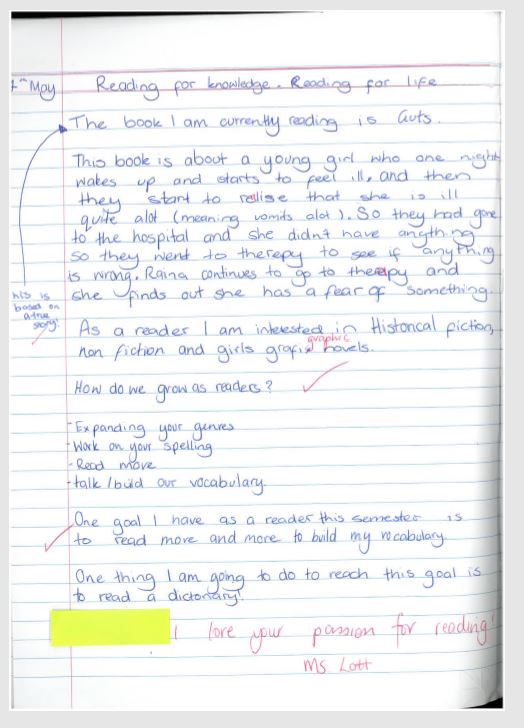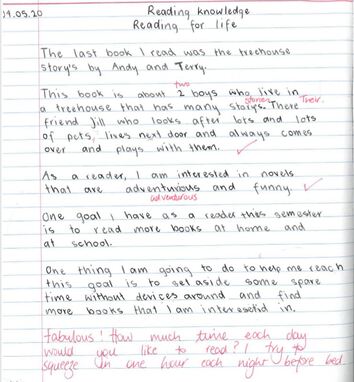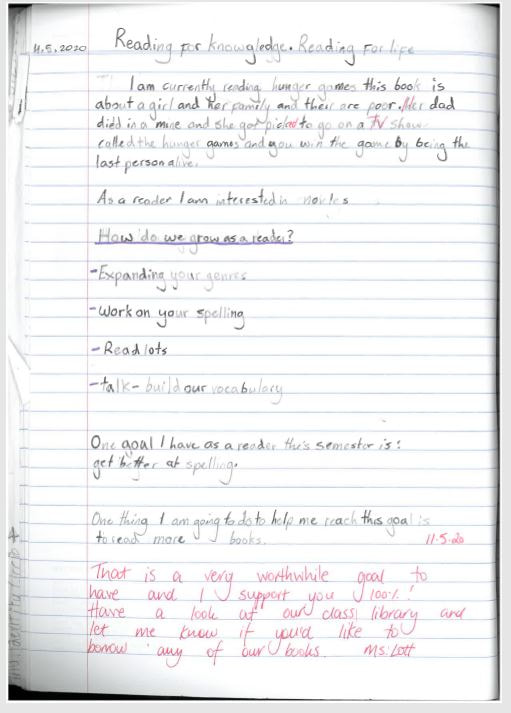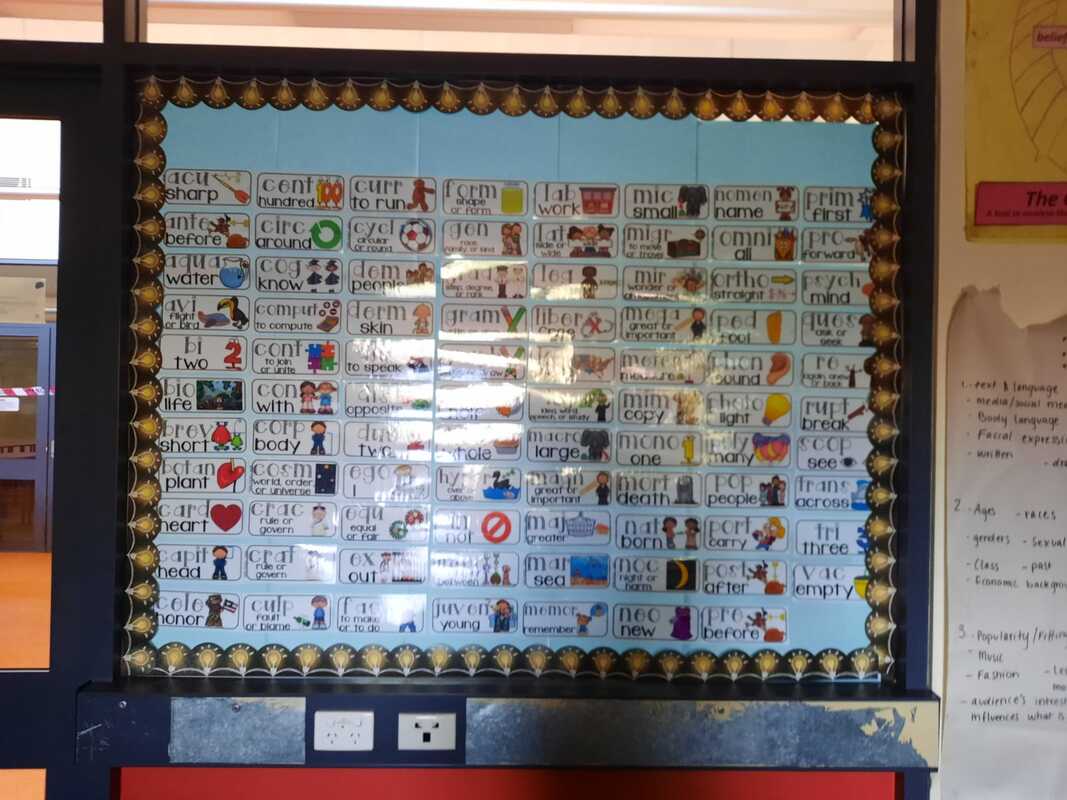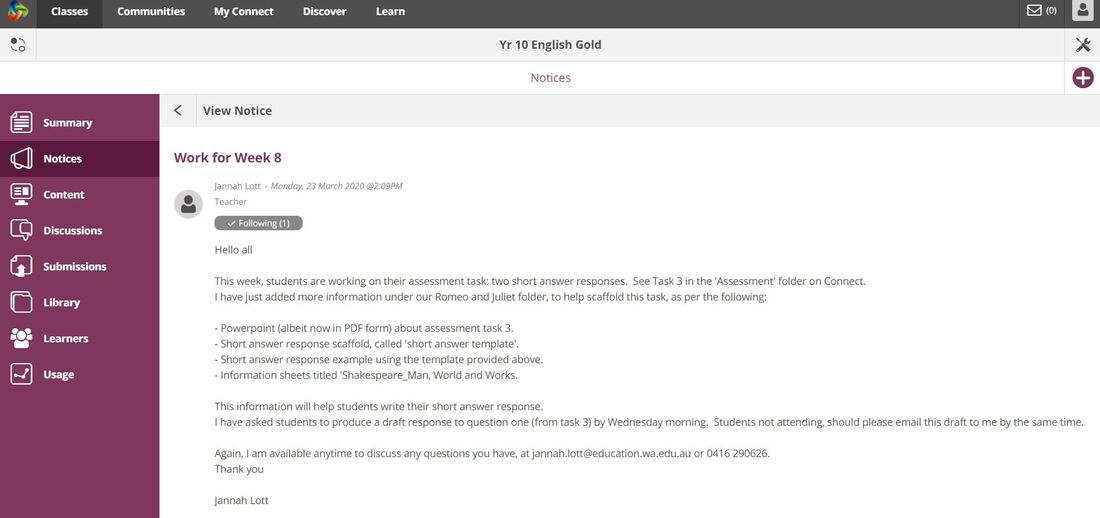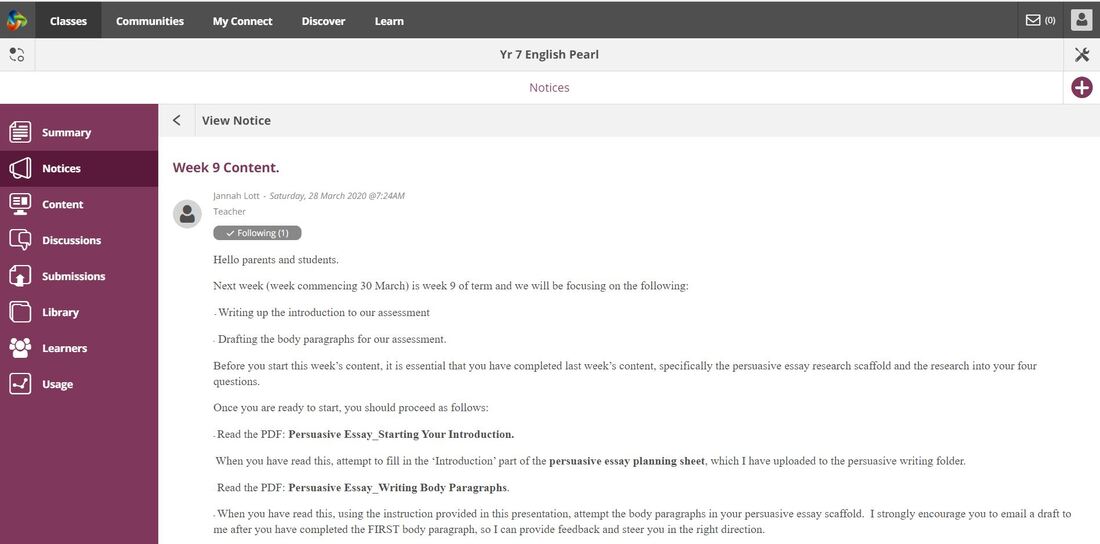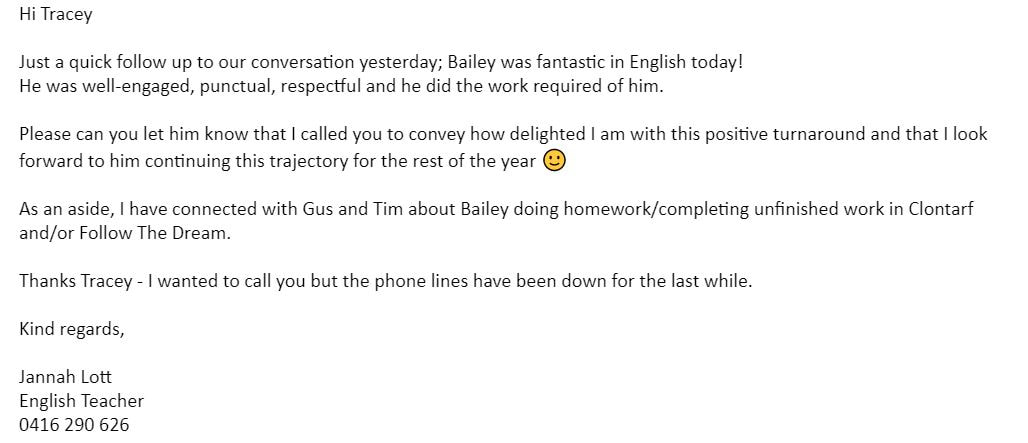Focus area 3.1. Establish challenging learning goals.
Set explicit, challenging and achievable learning goals for all students.
While students shared broad goals in terms of outcomes and corresponding assessments, a central part of my teaching practice has been to extend students where appropriate. One way of doing this was providing targeted personalised instruction. The examples shown here and here, demonstrate two instances where Year 9 English students, who were ahead of the general class on their narrative writing project, were given the personalised feedback required to progress their learning.
I have set explicit, challenging learning goals, targeted according to individual need as shown in this mini-lesson on paragraphs targeted to a Year 7 student who struggled with this aspect of writing. The email shown here demonstrates how I have worked cooperatively with parents as we support students in moving towards their learning goals. An email chain shown here, demonstrates how I have worked with a parent to identify a gap in learning for a particular student, outlined strategies to meet that need and reported back to the parent on progress towards that goal.
In addition to providing feedback in journals, I have provided explicit, challenging and achievable learning goals in end of semester reporting, so reports are not simply diagnostic but also provide direction in how to bridge the gap between what the student can do, and what the student should be able to do. An example of this is shown here.
In accordance with principles of effective learning, I have facilitated opportunities for students to set their own learning goals and encouraged them to reflect on progression towards them. Examples of this are shown below.
Set explicit, challenging and achievable learning goals for all students.
While students shared broad goals in terms of outcomes and corresponding assessments, a central part of my teaching practice has been to extend students where appropriate. One way of doing this was providing targeted personalised instruction. The examples shown here and here, demonstrate two instances where Year 9 English students, who were ahead of the general class on their narrative writing project, were given the personalised feedback required to progress their learning.
I have set explicit, challenging learning goals, targeted according to individual need as shown in this mini-lesson on paragraphs targeted to a Year 7 student who struggled with this aspect of writing. The email shown here demonstrates how I have worked cooperatively with parents as we support students in moving towards their learning goals. An email chain shown here, demonstrates how I have worked with a parent to identify a gap in learning for a particular student, outlined strategies to meet that need and reported back to the parent on progress towards that goal.
In addition to providing feedback in journals, I have provided explicit, challenging and achievable learning goals in end of semester reporting, so reports are not simply diagnostic but also provide direction in how to bridge the gap between what the student can do, and what the student should be able to do. An example of this is shown here.
In accordance with principles of effective learning, I have facilitated opportunities for students to set their own learning goals and encouraged them to reflect on progression towards them. Examples of this are shown below.
Focus area 3.2. Plan, structure and sequence learning programs.
Plan and implement well-structured learning and teaching programs or lesson sequences that engage students and promote learning.
Starting in Term 3, 2019 as a High School English teacher at Broome Senior High School I was involved in organising content into coherent, well-sequenced learning and teaching programs for cohorts in Years 7, 9 and 11 respectively. The example shown here provides evidence by way of a Year 9 unit, co-designed with the school Head of Learning Area, demonstrating my ability to develop a well-sequenced unit of learning. Supporting this unit of learning in an assessment schedule reflecting a back-ward mapping approach to planning and teaching.
The mini unit shown here is evidence of my capability to adapt existing learning programs based on identified need or interest. In this case, poetry had not been on our learning plan for the semester. However, students expressed a keen interest in poetry, particularly spoken word, and so I amended the semester plan to capitalise upon this interest.
Plan and implement well-structured learning and teaching programs or lesson sequences that engage students and promote learning.
Starting in Term 3, 2019 as a High School English teacher at Broome Senior High School I was involved in organising content into coherent, well-sequenced learning and teaching programs for cohorts in Years 7, 9 and 11 respectively. The example shown here provides evidence by way of a Year 9 unit, co-designed with the school Head of Learning Area, demonstrating my ability to develop a well-sequenced unit of learning. Supporting this unit of learning in an assessment schedule reflecting a back-ward mapping approach to planning and teaching.
The mini unit shown here is evidence of my capability to adapt existing learning programs based on identified need or interest. In this case, poetry had not been on our learning plan for the semester. However, students expressed a keen interest in poetry, particularly spoken word, and so I amended the semester plan to capitalise upon this interest.
Focus area 3.3. Use teaching strategies.
Select and use relevant teaching strategies to develop knowledge, skills, problem solving and critical and creative thinking.
As part of a commitment to student literacy and in keeping with the whole-school literacy approach of Broome Senior High School, I have taught mini lessons in specific facets of grammar and spelling. For this, I have used explicit methods and embedded revision as a core component. Examples of such mini lessons are shown here and here. Further examples of explicit teaching strategies are shown here, where I used such methods to teach students the genre of free verse poetry.
As part of a goal to develop student knowledge and skills in problem solving and critical and creative thinking, in Semester 1, 2020, I worked in cooperation with a colleague from Broome Senior High School's Cultural Centre to deliver lessons on critical thinking, particularly in relation to discussions around race and white privilege which were topical at that time. The purpose of such, was to get students thinking about how to approach and discuss complex issues. Samples of notes made during these lessons are shown here, and photos are displayed below.
Select and use relevant teaching strategies to develop knowledge, skills, problem solving and critical and creative thinking.
As part of a commitment to student literacy and in keeping with the whole-school literacy approach of Broome Senior High School, I have taught mini lessons in specific facets of grammar and spelling. For this, I have used explicit methods and embedded revision as a core component. Examples of such mini lessons are shown here and here. Further examples of explicit teaching strategies are shown here, where I used such methods to teach students the genre of free verse poetry.
As part of a goal to develop student knowledge and skills in problem solving and critical and creative thinking, in Semester 1, 2020, I worked in cooperation with a colleague from Broome Senior High School's Cultural Centre to deliver lessons on critical thinking, particularly in relation to discussions around race and white privilege which were topical at that time. The purpose of such, was to get students thinking about how to approach and discuss complex issues. Samples of notes made during these lessons are shown here, and photos are displayed below.
Focus area 3.4. Select and use resources.
Select and/or create and use a range of resources, including ICT to engage students in their learning.
The COVID-19 pandemic of 2020, provided the context by which ICT become fully embedded in pedagogy. During this time, the Department of Education's portal Connect became one of the main ways to communicate with students and provide learning experiences using ICT. Screenshots shown below demonstrate some of the ways I used this portal.
I have sought to use ICT as a tool to engage students in their learning. One example of this is my regular use of programs such as Kahoot to provide opportunities for students to revise content covered. This has proven incredibly engaging and effective. An example shown here demonstrates my use of Kahoot to revise Tier 2 vocabulary taught during a Year 7 novel study of The Amber Amulet. The image below demonstrates a display I created, a 'morpheme wall' to teach students about the concept of morphemes and apply this understanding to their reading and writing.
Select and/or create and use a range of resources, including ICT to engage students in their learning.
The COVID-19 pandemic of 2020, provided the context by which ICT become fully embedded in pedagogy. During this time, the Department of Education's portal Connect became one of the main ways to communicate with students and provide learning experiences using ICT. Screenshots shown below demonstrate some of the ways I used this portal.
I have sought to use ICT as a tool to engage students in their learning. One example of this is my regular use of programs such as Kahoot to provide opportunities for students to revise content covered. This has proven incredibly engaging and effective. An example shown here demonstrates my use of Kahoot to revise Tier 2 vocabulary taught during a Year 7 novel study of The Amber Amulet. The image below demonstrates a display I created, a 'morpheme wall' to teach students about the concept of morphemes and apply this understanding to their reading and writing.
Focus area 3.5. Use effective classroom communication
Use effective verbal and non-verbal communication strategies to support student understanding, participation, engagement and achievement.
I understand the pivotal role of communication and feedback in the cycle of teaching, learning and assessment. Examples of feedback are shown here and here.
In the first semester of 2020, our school required a very swift transition from traditional class-based learning to distance learning as students began to stay at home due to the COVID-19 outbreak. During this time, I provided electronic communication to students who submitted work via email. Examples of electronic feedback given to students at this time, are shown here and here. During this time, electronic communication become a key component of our learning and I became adept in using Connect, the Department of Education's online learning portal. Images shown below demonstrate some of the ways in which I used this portal to communicate with students during this unprecedented time.
Use effective verbal and non-verbal communication strategies to support student understanding, participation, engagement and achievement.
I understand the pivotal role of communication and feedback in the cycle of teaching, learning and assessment. Examples of feedback are shown here and here.
In the first semester of 2020, our school required a very swift transition from traditional class-based learning to distance learning as students began to stay at home due to the COVID-19 outbreak. During this time, I provided electronic communication to students who submitted work via email. Examples of electronic feedback given to students at this time, are shown here and here. During this time, electronic communication become a key component of our learning and I became adept in using Connect, the Department of Education's online learning portal. Images shown below demonstrate some of the ways in which I used this portal to communicate with students during this unprecedented time.
Focus area 3.6. Evaluate and improve teaching programs.
Evaluate personal teaching and learning programs using evidence including feedback from students and student assessment data, to inform planning.
As a matter of course, I consistently seek to obtain feedback from students regarding their understanding and progression towards learning goals, as shown here. I have also sought feedback from students regarding their performance in exams, and subsequently used this data in class to discuss the fairness of exams and inform future planning, as shown here.
As part of my transition to full registration, I participated in the Department of Education WA's Graduate Teacher Modules. During this time, I was explicitly exposed to evidence based teaching practices and engaged collegially with other graduate teachers to improve practice.
Evaluate personal teaching and learning programs using evidence including feedback from students and student assessment data, to inform planning.
As a matter of course, I consistently seek to obtain feedback from students regarding their understanding and progression towards learning goals, as shown here. I have also sought feedback from students regarding their performance in exams, and subsequently used this data in class to discuss the fairness of exams and inform future planning, as shown here.
As part of my transition to full registration, I participated in the Department of Education WA's Graduate Teacher Modules. During this time, I was explicitly exposed to evidence based teaching practices and engaged collegially with other graduate teachers to improve practice.
Focus area 3.7. Engage parents/carers in the educative process.
Plan for appropriate and contextually relevant opportunities for parents/ carers to be involved in their children’s learning.
As a High School English teacher, I have participated and continue to participate in parent-teacher meetings where I engage with parents and carers regarding student learning and development. I also connect with parents on a regular basis, just to ensure our alignment on goals for students' learning. Here is a typical example of an email sent to a parent to organise a conversation regarding a Year 9 student's progress in English. Further samples of communication with parents are shown in the images below.
Plan for appropriate and contextually relevant opportunities for parents/ carers to be involved in their children’s learning.
As a High School English teacher, I have participated and continue to participate in parent-teacher meetings where I engage with parents and carers regarding student learning and development. I also connect with parents on a regular basis, just to ensure our alignment on goals for students' learning. Here is a typical example of an email sent to a parent to organise a conversation regarding a Year 9 student's progress in English. Further samples of communication with parents are shown in the images below.
As part of my commitment to working collaboratively with families, I continuously seek to engage with parents and carers in the educative process. An email chain shown here, demonstrates how I have worked with a parent to identify a gap in learning for a particular student, outlined strategies to meet that need and reported back to the parent on progress towards that goal.
